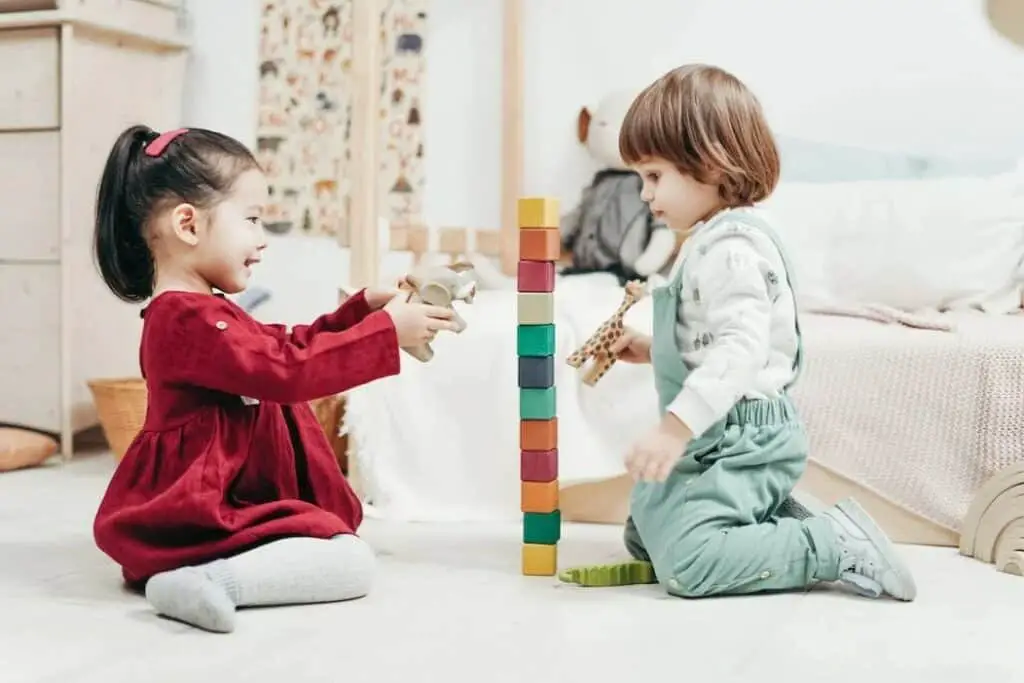Playing comes naturally to children; it’s their way to keep active, explore their environment, and have fun. However, there’s a whole lot more going on during playtime than just fun and games, especially when children engage in a type of play known as associative play.
Kids learn essential social skills and develop cognitive abilities during this stage of play as they interact and communicate with each other. But exactly what is associative play? Why is it important, and how do you encourage children to engage in it?
This quick post serves up answers, so keep reading if you’re a parent, caregiver, educator, or just curious to know.
What Is Associative Play?
Ever seen children playing together but each child doing their own thing? What you’re witnessing is kids taking part in associative play.
To give a working definition for the purpose of this article, associative play is when kids play together but don’t necessarily play the same games, follow the same rules, or have a common goal.
Children playing associatively will interact and communicate with each other. They may even share the same toys and take turns. However, each child is doing a different thing while playing alongside other children.
This stage of play allows little kids to learn from each other and develop social skills without concerning themselves with having shared goals or following specific rules.
According to Mildred Parten Newhall, an American sociologist, there are six stages of play. These include:
- Unoccupied play: An infant observing their environment without playing in the traditional sense.
- Solitary play: A child plays by themselves without interacting with other kids.
- Onlooker play: The child begins to develop an interest in other kids playing around but does not interact with them.
- Parallel play: The child does not interact with others during play but may do the same activity as them.
- Associative play: The child plays alongside other kids and has some interactions, but there is no organization or coordination.
- Cooperative play: The child actively plays and interacts with others with coordinated efforts.
What Associative Play Looks Like
Think of associative play like undirected play; it involves each child exploring their environment and engaging in activities that interest them while interacting with other young children.
In other words, parents and caregivers don’t need to worry too much about making children participate in associative play. Simply providing the right environment ― a safe play area with multiple options for playing ― is enough to encourage children to engage with each other.
Here are a few examples of what associative play may look like:
- Kids share similar toys but play different games
- Children dancing together but are not bothered with being in sync
- Children ride tricycles together, but each goes their own way
- Preschoolers play with toy blocks without any organization or plan
- Kids draw on the same canvas, with each creating their own image
- Little children run together without competing
The Typical Age for Associative Play
Typically, children will start to play associatively when they are around 3 or 4 years old and continue until they turn 5.
However, it is not uncommon for some kids to enter this stage as early as 2, and others may continue playing this way, even when they are already at the stage of cooperative play.
In other words, every child is unique and develops at their own pace, so there’s no need to worry if your preschooler plays alone occasionally. Independent play is perfectly normal.
That said, if your preschool-aged child tends to engage in solitary play all the time, you should find ways to encourage them to play with other kids of the same age. I’ll cover how to do that correctly in a bit.
Why Is Associative Play Important for Children’s Development?
Now that we’ve answered the question, “What is associative play?”, let’s briefly discuss its importance.
Firstly, this stage of play provides the opportunity for kids to develop a sense of community from an early age. By learning to interact with other children respectfully, kids develop positive social skills for building healthy relationships.
Associative play is also crucial in developing critical thinking and problem-solving skills in children. It allows kids to do their own thing ― come up with their own activities and games. In addition to encouraging creativity and imagination, this type of play helps children to develop a sense of independence.
Also, by interacting with other children, kids get to practice language skills, develop attention span, and improve their memory. And by spending time with their peers, children can have fun while building self-esteem and confidence.
What Are the Benefits of Associative Play?

Associative play, as well as all different stages of play, has plenty of impact on healthy child development, as research shows.
Other benefits include:
Teaches Cooperation and Sharing
Unlike the cooperative play stage, children don’t coordinate their efforts in the associative play stage. Still, this stage encourages sharing common resources, like toys and coloring supplies.
Although children only have little interaction at this stage, taking part in this type of play prepares them for healthy participation in group activities as they grow older.
Stimulates Healthy Brain Development
Playing with others allows children to explore their environment using their imagination. Also, children tend to be highly curious at this stage of play, causing an increase in their thinking capacity, cognition, and ability to concentrate. Research shows that these activities stimulate healthy brain development.
Encourages Respect
Associative play teaches children to respect others ― an important life-long skill. By doing fun activities that involve taking turns (such as playing on slides and swings), children learn to play in groups.
Also, kids will learn that certain toys belong to others, so they will learn to cooperate with other kids to use their toys.
Promotes Language Development
As children interact with others in little ways, they learn to put words to their feelings and express themselves in simple sentences. In addition to building vocabulary, this stage of play helps kids to learn the basics of communication.
Improves Problem-Solving Skills
Since there are no rules or goals during the associative play stage, children can be more creative and find solutions to the problems they encounter during play by doing things themselves.
As they face certain difficulties during play, children develop resilience to take on future challenges.
Keeps Children Physically Active
Playing along with others means children have more opportunities to take part in age-appropriate physical activities, like running, dancing, and hopping. These fun activities help to develop children’s motor skills, strengthen their bones and muscles, and keep their minds sharp.
Prepares Children for the Academic Environment
Playing side-by-side with other children fosters friendship and communication. These social-emotional skills can make school feel a bit more comfortable for young children as they are already used to mingling and sharing with kids in the same age group.
Simple Ways to Encourage Associative Play
So far, we’ve covered the following: What is associative play? The importance of this play stage in early childhood development and its benefits.
It’s time to learn how to creatively encourage associative play. Here are a few tips to help you get started:
- Provide opportunities for your child to mingle and play with kids in the same age bracket.
- Ensure there are plenty of age-appropriate activities and options for play, and encourage your child to share their toys with other kids. You may have to model sharing in a social interaction to help your child grasp the concept.
- Encourage your kids to play games that involve taking turns.
- Take your child to parks, playgrounds, play dates, or other environments where they can play side-by-side with other children.
Encouraging associative play is great and all, but as I already mentioned, you don’t need to overthink the process. As an active parent, you only need to provide the right environment and let your child participate in the activities they are interested in at their own pace.
Of course, it is normal to be concerned if you think something is off with your child’s development. However, don’t make the mistake of nagging or pushing your child to play with others or share with them. Allow them to settle in and choose the activities they like themselves.
Instead of pushing your child to do what others are doing, consider talking with an expert like a pediatrician for help.
Final Thoughts
What is active play, and why should you encourage it? Hopefully, you now have all the answers and understand why it is important for your child’s development.
Remember that no two kids develop at the same pace, so don’t force your child into a stage when they are not ready.
You want to build and maintain a positive relationship with your child from an early age, and pushing them isn’t healthy for that relationship. Read this article to learn more about helpful parental roles that will nurture your parent-child relationship.




